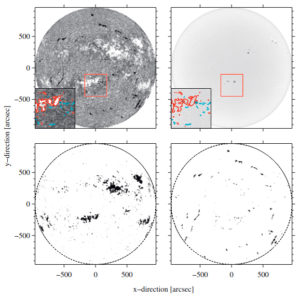Paper on solar H alpha emission
My group recently collaborated with the solar physics group and in particular Dr. Andrea Dierke for an investigation of solar H alpha emission. The paper is now published! 
(top left) and the corresponding mask for bright
(bottom left) and dark features (bottom right).
For comparison, we display the corresponding
continuum map from HMI/SDO (top right). (Dierke et al. 2022)
Solar H alpha excess during Solar Cycle 24 from full-disk filtergrams of the Chromospheric Telescope
Diercke, A.; Kuckein, C.; Cauley, P. W.; Poppenhäger, K.; Alvarado-Gómez, J. D.; Dineva, E.; Denker, C.
The chromospheric H-alpha spectral line is a strong line in the spectrum of the Sun and other stars. In the stellar regime, this spectral line is already used as a powerful tracer of stellar activity. For the Sun, other tracers (i.e, CaII K) are typically used to monitor solar activity. We used observations of full-disk H-alpha filtergrams of the Chromospheric Telescope (ChroTel) to extract the imaging H-alpha excess and deficit, which are related to bright features (plage regions) and dark absorption features (filaments and sunspots), respectively. The aim of this study is to introduce the imaging H-alpha excess and deficit as tracers of solar activity and compare them to other established indicators: the relative sunspot number, the F10.7cm radio flux, and the MgII index. The H-alpha excess and deficit follow the behavior of the solar activity over the course of the cycle, whereby the peak of the H-alpha deficit is shortly after the solar maximum. The H-alpha excess is closely correlated to the chromospheric MgII index. The highest correlation of the H-alpha deficit is found with the F10.7cm radio flux. The H-alpha deficit reflects the cyclic behavior of polar crown filaments and their disappearance shortly before the solar maximum. We investigated the mean intensity distribution for H-alpha excess regions for solar minimum and maximum, whereby the shape of the distributions is very similar, but with different amplitudes. Furthermore, we investigate whether the area coverage fraction or the changing H-alpha excess in the active regions dominates temporal variability in solar H-alpha observations. The area coverage fraction and the H-alpha excess are strongly correlated, whereas the weak correlation between the area coverage fraction and mean intensity leaves us pessimistic that the degeneracy between these two quantities can be broken for the modeling of unresolved stellar surfaces.
eprint arXiv:2203.04357, accepted for publication in Astronomy & Astrophysics, March 2022